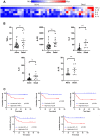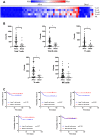Lymphocyte may be a reference index of the outcome of cancer patients with COVID-19
- PMID: 33735106
- PMCID: PMC8034957
- DOI: 10.18632/aging.202741
Lymphocyte may be a reference index of the outcome of cancer patients with COVID-19
Abstract
Background: The novel coronavirus infectious disease (COVID-19) is an international concern as it spreads through human populations and across national and international borders.
Methods: In this retrospective study, we consecutively included all cancer patients who had been identified as having a nucleic acid-confirmed COVID-19 from two designated hospitals in Wuhan, China. COVID-19 patients without cancer were also enrolled for comparison. The clinical data were gathered from the medical records from Jan 14 to March 12, 2020.
Results: Among the 117 cancer patients diagnosed with COVID-19, the median age was 63 years and 48.7% were male. Male sex, hematologic cancer, dyspnea on admission, and anti-cancer therapies were associated with an increased risk of mortality in cancer patients with COVID-19. We found that elevated levels of TNF-α, IL-2R, IL-6, and IL-8 were associated with a poorer prognosis in cancer patients with COVID-19, but no statistically significant association was found in patients without cancer. In addition, IL-2R and IL-6 markedly decreased in cancer patients who recovered from COVID-19. However, lymphocyte subsets were diminished in cancer patients who died from COVID-19, including total T cells, total B cells, helper T (Th) cells and suppressor T (Ts) cells.
Conclusions: Cancer patients with COVID-19 were associated with high mortality (23.9%). A decrease in lymphocyte subsets and higher levels of cytokines were associated with a higher risk of severe outcome and could be utilized as the reference index to predict the survival outcome of cancer patients with COVID-19.
Keywords: COVID-19; cancer; cytokines; lymphocytes; survival time.
Conflict of interest statement
Figures



Similar articles
-
Dynamic changes in lymphocyte subsets and parallel cytokine levels in patients with severe and critical COVID-19.BMC Infect Dis. 2021 Jan 18;21(1):79. doi: 10.1186/s12879-021-05792-7. BMC Infect Dis. 2021. PMID: 33461503 Free PMC article.
-
Clinical Characteristics and Immune Responses of 137 Deceased Patients With COVID-19: A Retrospective Study.Front Cell Infect Microbiol. 2020 Dec 7;10:595333. doi: 10.3389/fcimb.2020.595333. eCollection 2020. Front Cell Infect Microbiol. 2020. PMID: 33365277 Free PMC article.
-
Cytokines and their relationship with the severity and prognosis of coronavirus disease 2019 (COVID-19): a retrospective cohort study.BMJ Open. 2020 Nov 30;10(11):e041471. doi: 10.1136/bmjopen-2020-041471. BMJ Open. 2020. PMID: 33257492 Free PMC article.
-
Characteristics of inflammatory factors and lymphocyte subsets in patients with severe COVID-19.J Med Virol. 2020 Nov;92(11):2600-2606. doi: 10.1002/jmv.26070. Epub 2020 Jun 9. J Med Virol. 2020. PMID: 32470153 Free PMC article.
-
Peripheral Inflammatory Cytokines and Lymphocyte Subset Features of Deceased COVID-19 Patients.Biomed Res Int. 2021 Jan 22;2021:9101082. doi: 10.1155/2021/9101082. eCollection 2021. Biomed Res Int. 2021. PMID: 33542929 Free PMC article.
Cited by
-
Co-infection associated with SARS-CoV-2 and their management.Future Sci OA. 2023 Feb 3;8(9):FSO819. doi: 10.2144/fsoa-2022-0011. eCollection 2022 Oct. Future Sci OA. 2023. PMID: 36788985 Free PMC article. Review.
-
Reduced Absolute Count of Monocytes in Patients Carrying Hematological Neoplasms and SARS-CoV2 Infection.Cancers (Basel). 2022 Feb 24;14(5):1173. doi: 10.3390/cancers14051173. Cancers (Basel). 2022. PMID: 35267478 Free PMC article.
-
Comparison of clinical outcomes and risk factors for COVID-19 infection in cancer patients without anticancer treatment and noncancer patients.Front Public Health. 2022 Aug 12;10:925519. doi: 10.3389/fpubh.2022.925519. eCollection 2022. Front Public Health. 2022. PMID: 36033814 Free PMC article.
References
-
- Al-Abdallat MM, Payne DC, Alqasrawi S, Rha B, Tohme RA, Abedi GR, Al Nsour M, Iblan I, Jarour N, Farag NH, Haddadin A, Al-Sanouri T, Tamin A, et al., and Jordan MERS-CoV Investigation Team. Hospital-associated outbreak of Middle East respiratory syndrome coronavirus: a serologic, epidemiologic, and clinical description. Clin Infect Dis. 2014; 59:1225–33. 10.1093/cid/ciu359 - DOI - PMC - PubMed
-
- Ksiazek TG, Erdman D, Goldsmith CS, Zaki SR, Peret T, Emery S, Tong S, Urbani C, Comer JA, Lim W, Rollin PE, Dowell SF, Ling AE, et al., and SARS Working Group. A novel coronavirus associated with severe acute respiratory syndrome. N Engl J Med. 2003; 348:1953–66. 10.1056/NEJMoa030781 - DOI - PubMed
-
- de Groot RJ, Baker SC, Baric RS, Brown CS, Drosten C, Enjuanes L, Fouchier RA, Galiano M, Gorbalenya AE, Memish ZA, Perlman S, Poon LL, Snijder EJ, et al.. Middle East respiratory syndrome coronavirus (MERS-CoV): announcement of the coronavirus study group. J Virol. 2013; 87:7790–92. 10.1128/JVI.01244-13 - DOI - PMC - PubMed
Publication types
MeSH terms
Substances
LinkOut - more resources
Full Text Sources
Other Literature Sources
Medical

